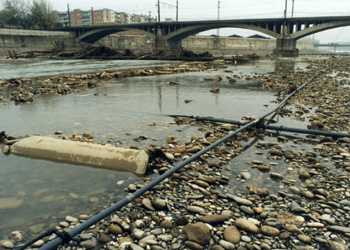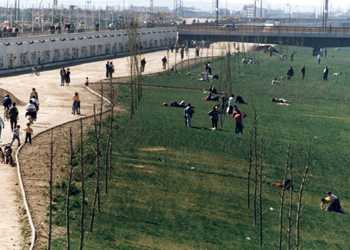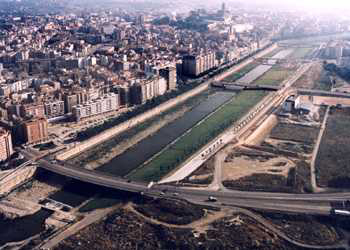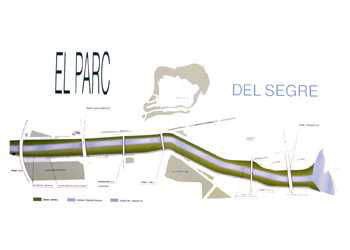Previous state
The Segre River, which runs through the city of Lleida, has created major problems for its inhabitants over the course of history. The period between 1950 and 1970 was the time of the city's major economic and urbanistic development. However, no attempts were made to integrate the river into the city and it became a barrier which prevented connectivity between the city centre and the shanty districts and settlements on the left bank of the river, occupied by gypsies. In 1982 the river burst its banks, causing partial flooding of the city, and leading to demands by the inhabitants to find a solution to the problem. Furthermore, the water and the riverside areas were subjected to an unsustainable process of deterioration due to the direct dumping of pollutants and waste at a point in the river where the shanty dwellers, fishermen and canoeists would go to wash their cars, collect wood or practise their sport --actions which had a negative impact on the river's ecosystem. More specifically, these unchecked activities, threatened, among other things, the preservation of La Mitjana, an area of great ecological value situated at the point where the river entered the city.Aim of the intervention
Pressure from the city's inhabitants led Lleida Municipal Council to decide to carry out the programme which would reorganise the area of the river at the point where it ran through the city. The project focused on the following points: channelling the urban stretch of the river to reduce the risk of flooding; integrating the river into the city, thus eliminating the barrier effect which prevented fluid communication between both banks; eliminating marginal activities on the riverbank; boosting recreational and educational uses by ordering its adjacent spaces and programming activities related to environmental education; the improvement of the quality of the river water by controlling the dumping of pollutants; and protecting the river's ecosystem in the zone of La Mitjana. The initiative for this ambitious programme was spearheaded and coordinated by Lleida Municipal Council and its team of experts who undertook to foster and negotiate politically the opportune interventions in order to involve other administrations (Ministry for Development and the Catalan government, the Generalitat de Catalunya) and obtain their financial and technical support.Description
The channelling of the Segre River has guaranteed a permanent, stable surface of water, and has converted the adjacent spaces into a vast linear city park. The urban dimensions of the project have allowed the channelling of the river, not just understood as a major work of hydraulic engineering, but as a generator of recreational spaces for the city's inhabitants. The basic design consists of a low-water channel, 36 m wide, located centrally with regard to one of the central openings in the existing bridges and a slightly sloping zone towards the side which has a vast green carpet consisting of 16,000 m2 of grass (especially resistant to flooding through its treatment with ecological fertiliser and phosphosilicate which is retained by the soil) that is only liable to flood during a few days of the year and is suitable for recreational purposes over the remaining months. The right bank is structured as a linear strip which combines rectangular patches of lawn and rocks. The park is equipped with all the necessary furniture (850 lighting points) and has 700 trees belonging to three different species. Furthermore, running parallel to the park, an urban avenue, almost 3 km in length, has been created at the height of the walls, and has contributed to making the site a focal point. An outstanding feature of the intervention is the accessibility of the entire site, which is linked to the side walkways by stairways and ramps. In order to reduce the level of water pollution, a water-purification plant has been built (in operation since 1994) and a redevelopment and management plan has been implemented in the zone of La Mitjana, converting it into a natural park of almost 100 hectares with 4 zoned areas: public areas for recreational and sporting activities; an environmental zone for educational purposes; a nature zone with spaces for the observation of fauna and flora; and a natural reserve of great biological interest. After La Mitjana, by Pardinyes lock, there is a small lake which gradually narrows until the start of the low-water channel, acting as an antechamber to the great city park. The entire intervention has been completed with the building of three new bridges which improve connectivity between the different districts on both sides of the river (Pont de la Universitat 1993, Cappont pedestrian walkway 1999 and Pont de Pardinyes 1995 -- all three are 160 m long).Assessment
All the interventions have tried to include the different social groups involved and along these lines, Lleida Municipal Council has promoted the organisation of residents' movements, and given its support to the participation of residents' associations in the neighbourhoods involved and the fishing and canoeing clubs. In order to foster residents' participation, the corporation ran a campaign disseminating the interventions in the programme which was seconded by a number of environmental associations, by the Architects' Association and the Pardinyes Residents' Association, among others. The initial objectives have been fulfilled, and, as a consequence, the barrier effect of the river has been eliminated and new life injected into the historic centre of the city and its commercial activities. It is now easier for residents to get from one district to another and the use of cars has decreased as a result. The city park is used a great deal by the inhabitants and means that they don't have to go outside the city for sporting or recreational activities. The quality of the water has improved and riverside vegetation has been restored. The intervention has brought about a high level of participation in the environmental education projects in the Natural Park of La Mitjana (5,000 visitors a year). However, some marginal activities, which have a negative impact on the environment, have moved to other sites and have not disappeared completely. Today, the risk of flooding by the river bursting its banks is practically nil (the intervention allows for a volume of flow of up to 3,500 m3 a second). The Parc del Segre has become, without a doubt, one of the biggest and most important riverside parks in Europe.Albert García Espuche, architect
[Last update: 02/05/2018]










